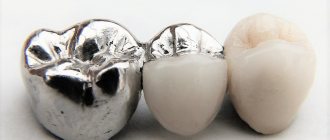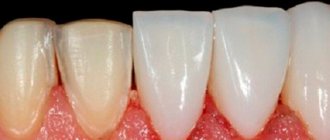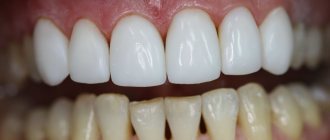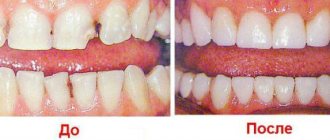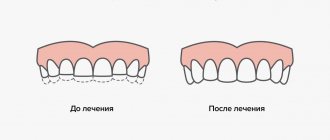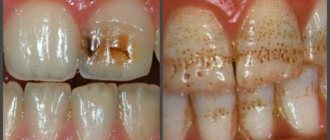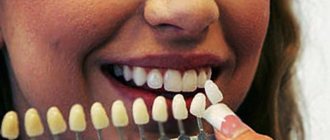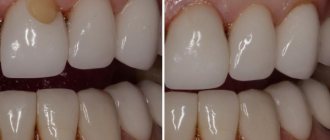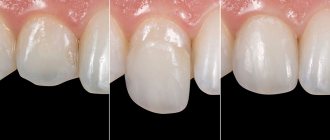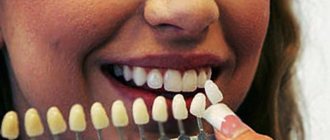When veneers appeared: history of creation
This medical technique is not considered a new invention.
According to historical facts, the first prototypes of veneers, which are used by dentists now, began to enter people's lives at the beginning of the 20th century. The first to use this technique were actors from the USA. The author of the veneers is Ch. Pincus, a Californian dentist originally from France. Since 1928, when veneers appeared, he has been using thin overlays to help Hollywood stars hide their ugly smiles and disguise the yellow tint during close-up filming of films. The doctor used abrasive powder intended for dental prosthetics. Ceramic structures were fixed to the outer area, which later became known as veneers. The disadvantage of the restoration system was the minimum period of operation, that is, it was installed only at the time of shooting. This was due to the fact that imperfections in technology did not allow the plates to stay on the teeth for a long time. The medical appointment has become another type of setting for Hollywood cinema.
Veneers coped with the task - they hid defects. They allowed me to create the most attractive aesthetic smile that everyone dreams of. Charles Pincus gained incredible popularity, and people began to call him “The Dentist to the Stars,” because his clients were only actors and celebrities.
This camouflage continued until the early 80s. At this time, scientists were able to develop composite adhesive compositions and equipment for etching contact shells, which made it possible to firmly fix veneers for a long time with the possibility of functional load on bone objects. After such a breakthrough in the dental field, a new era of cosmetic medicine began, which made it possible not only for movie stars, but also for ordinary people to get an attractive smile and straight teeth.
Today, everyone can install veneers for themselves, thanks to advanced technology. Using the search portal zubza.ru you can make an appointment at any metropolitan clinic online. Just fill out a short form, indicate the desired date and confirm your reservation by phone. Our operator will tell you current promotions, inform you about discounts, price lists and the number of vacancies for the coming days. The service has a real map of the city, where the rating clinics of the city are marked, information about the doctors practicing in them and reviews from visitors is provided. You can control your browsing history, accrual of bonus points and receive cashback of up to 5% on your bank card after installing the Zubza mobile application.
Questions and answers
Is it true that empress veneers installed in your clinics do not require grinding or removal of enamel?
Good afternoon Please tell me, is it really true that the empress veneers installed in your clinics do not require grinding and removal of enamel? In connection with what?
Hello! To install Empress veneers, grinding of the enamel is required to better attach the veneer and give the teeth an anatomical shape, but the grinding is not as deep as when installing other types of veneers, since Empress veneers are ultra-thin plates made of a unique high-strength material. You can find out more detailed information about the properties of Empress veneers and the features of their installation during a free consultation with our orthopedists. You can make an appointment by calling + 7 (495) 789-42-02. Sincerely, Patient Support Center SIMPLADENT++8 800 333-53-41
Is it possible to hide or disguise a crooked tooth with a veneer?
Good afternoon Tell me, is it possible to hide/disguise it with a veneer if a tooth is crooked? On my right, the fang goes inside the jaw. I don’t want to get braces, and I can’t afford the money for mouthguards. It seems like the solution is veneers, but I need your preliminary advice.
Hello! Theoretically, such defects can be corrected by installing veneers. However, only a doctor can answer you for sure based on the results of the examination. Come to our specialists for a free consultation, the doctor will explain to you all the details of veneer prosthetics and write out a treatment plan indicating the cost. Our clinic uses highly aesthetic Empress veneers made from ultra-strong ceramics. For more details and to sign up for a free consultation, please call +. Sincerely, Patient Support Center SIMPLADENT++8 800 333-53-41
Other questions
Other jobs
What are veneers
Veneers are very thin shells made of composite material, zirconium dioxide or ceramic. They are glued to the filed enamel surface with special cement in order to make the patient's front teeth ideal, i.e. hide all external cosmetic defects and imperfections: chips, cracks, unsightly shade, fillings, diastema, slight curvature.
This orthopedic solution has its pros and cons. For example, its advantages include high aesthetic results and low trauma during installation compared to crowns. And among the disadvantages is a fairly high price. Also, do not forget that grinding the enamel before installing veneers is still necessary, and this process is irreversible, because After removal, the teeth will no longer look the same as before.
When to install veneers on teeth
- for small chips of enamel,
- with curvature of the position of the teeth, but minor,
- if there are gaps in the row,
- in general, when the condition of the enamel is unsatisfactory - if it is weakened or has a dark shade that cannot be eliminated through the classical whitening procedure.
If the damage to the tooth is more serious, that is, if it is destroyed by more than 50%, affected by caries, or has large fillings on the front surface, veneers will not save you. In such cases, full prosthetics are required - for example, with crowns.
Chips on teeth - indications for restoration
Contraindications
- Pathological abrasion of teeth.
- Bruxism (teeth grinding).
- Bad habits: biting nails, opening bottles, cracking nuts, etc.
- Veneers are not recommended if the patient has an incorrect bite.
- Absence of 6 – 7 chewing teeth.
- Tooth decay on the tongue side.
- The presence of a large filling on the inside of the tooth.
- There is a risk of injury to the front teeth (hobby for boxing, etc.)
Advantages and disadvantages of veneers
The main advantage of microprostheses is the ability to correct visible dental defects and a beautiful smile. Other advantages of this method include the following points.
- Painless procedure.
- Quick visible results.
- Durability of microprostheses (with the exception of composite veneers).
- Naturalness of the dentition.
- Preservation of natural tooth functions.
But, despite all the advantages, this method of orthopedic treatment also has a number of disadvantages. As a rule, they can be encountered as a result of improper installation of the plate or careless handling of the new prosthesis.
- Injury to the gums during installation.
- Peeling of the lining.
- Change of plate color.
- Relative strength of the prosthesis.
- High cost of treatment.
- Need to be replaced after expiration of service life.
- In very rare cases, destruction of the tooth covered with the onlay occurs. The dentist may not notice the existing disease and simply install a plate, under which inflammation and destruction develop.
Important! The main disadvantage of veneers is the irreversibility of the procedure, since after grinding, tooth enamel will never recover on its own. If the plates are rejected, it will have to be restored or a crown installed.
Are veneers right for you?
Cases where it is necessary to quickly correct defects in the dentition, “tighten” underdeveloped teeth, and eliminate the wedge-shaped effect are considered ideal for veneers. They are also suitable for correcting mild enamel erosion. However, in some cases, dental veneers cannot be installed. The reason is low efficiency or danger to the patient’s health. Contraindications include:
- severe malocclusion;
- lack of chewing teeth;
- the habit of grinding teeth (bruxism), biting threads, opening bottles with teeth, gnawing nuts, etc.;
- missing more than half of a tooth or a large filling on the inner surface;
- pathological abrasion of teeth;
- dental treatment with resorcinol - formalin method.
This is interesting: Aligners for straightening teeth Invisalign - indications for using a mouth guard
Veneers are not installed in the presence of severe caries or gum disease.
If only one tooth in a row is badly damaged, you can install a crown on it and cover the rest of the row with veneers. The main thing here is to choose veneers and crowns from the same material so that the teeth look the same.
When is it necessary to install lumineers?
Lumineers
There are indications for dentition correction with lumineers. You can get lumineers if you have:
- There are cracks and chips in your teeth;
- The color of the enamel has changed and cannot be bleached;
- There are gaps between the teeth;
- Malocclusions that do not affect health and do not need to be corrected with braces;
- If your teeth are prone to wear;
- Weak enamel, susceptible to damage;
- Uneven teeth that you want to correct;
- Various spots and spots that cannot be removed by other methods.
The color of lumineers is selected individually according to a special scale, so your teeth will look natural. Installation is carried out on the front teeth of at least 8 units. It is impossible to install a lumineer on one tooth, as it will be very different from the rest of the dentition.
What are removable veneers and what are they for?
These are temporary overlays or caps made of plastic that the doctor installs on the teeth after preparing the enamel and taking impressions. The fact is that permanent veneers still need to be made in a dental laboratory so that they recreate the anatomy of the patient’s natural teeth as accurately as possible and look natural. The production of onlays can take from 1 week to a month, it all depends on the workload of the laboratory. During this period of time, the ground enamel does not look very aesthetically pleasing, and without temporary overlays it will also remain defenseless against external influences: bacteria, plaque, temperature and hardness of food.
To protect the ground enamel, doctors resort to the use of removable veneers. The plates are made of plastic and attached with glue, which, however, can be easily removed in the dental office. Such onlays allow you to protect your teeth while the patient is waiting for a follow-up appointment with the orthopedist.
Indications for installing removable pads
- long waiting period for the production of permanent dentures,
- the need to preserve the aesthetics of a smile (for example, among people in public professions, artists, models, etc.),
- the need for additional protection of teeth (from plaque or microtrauma).
Contraindications for removable veneers
Despite all the advantages of the product, in some cases its installation is impossible for the following reasons:
- several front row units have significant damage, defects and chips,
- Most of the front teeth have fillings,
- there is an uncorrected malocclusion,
- Diagnosed with bruxism (grinding teeth during sleep).
Examples of work “Before” and “After”
Restoring aesthetics with lumineers
Case: the patient complained of unsatisfactory aesthetics of the anterior teeth (yellow enamel, curvature).
Aesthetic restoration of anterior teeth - lumineers
Case: the patient complained about the unsatisfactory aesthetics of his smile (he was not satisfied with the color and shape of the teeth), since the teeth were not affected by caries, the curvature was small, the patient chose the most non-traumatic restoration option - installing lumineers without grinding and depulping the teeth.
What are temporary veneers, why get them and how long will you have to wear them?
Today, installing veneers that make a smile attractive is a procedure that is available to everyone. And almost a century ago, only Hollywood actors could afford them, and even then not for long - only for the period of time while filming took place. Celebrity stylists put thin plates on the teeth as a kind of make-up or disguise defects, and glued them with a temporary composition. After 1-2 days, such overlays were removed. Today, high-quality veneers that are installed in dental offices are permanent structures that serve their owners for 5-7 or more years (depending on the properties of the selected material). However, on the Internet you can find information about removable veneers. What are these structures? Find out more in our article today!
Do you really need veneers? Or can you still do without them?
I want a beautiful smile and not ruin my teeth with veneers!
Doctor Arkashov
: Sharpening your teeth at a young age is not the best option.
Anna
: How can I make my smile beautiful? It's either veneers or my teeth can be moved into the correct position.
What teeth are veneers placed on?
Veneers can be placed on any teeth if there are no contraindications. Most often, veneers are placed on the front teeth, and they can be filled, with crowns and bridges.
It is important that the plates are installed symmetrically relative to the center line. That is, they can be fixed on 2-4 central incisors or covered with microprostheses on 6-8 front teeth. This is due to the fact that it is quite difficult for a dental technician to choose a shade of material that will perfectly match the color of your natural teeth.
Are there any contraindications
Although plates are used only to improve the aesthetics of the smile area, their use has contraindications:
- the tooth is destroyed by more than a third;
- large filling area;
- bruxism (teeth grinding creates significant stress and leads to damage to the lining);
- direct or deep bite;
- extreme sports with a high risk of dental damage;
- hypersensitivity of dental units;
- periodontitis (installation begins after gum treatment).
Lumineers are not used for significant defects in the smile area.
Types of veneers
Microdentures for teeth are made from several types of materials. Each of them has pros and cons that need to be discussed in more detail. The plates are made from the following materials:
- ceramics;
- composite material;
- porcelain.
The most popular type is ceramic veneers. High-quality materials are always used for their production. The entire manufacturing process takes place only in laboratory conditions. To install the plates, the patient must go to the orthodontist and only after diagnosis begin the installation procedure . After grinding the teeth, the doctor makes an impression and sends it to make veneers.
The classic manufacturing method is most often used. Aluminum oxide or zirconium is used for spraying; they are particularly durable. The thin thickness of the plates allows for ideal alignment, since the plates adhere well to the tooth surface. They do not darken, are very durable and are not susceptible to coloring pigments. It is important that this type of material does not cause allergies. Thanks to the wide range of materials offered, veneers are difficult to distinguish from natural enamel. Among the disadvantages is the inability to change the position of the plate after it is fixed. It is also worth noting the high cost of the products .
Reflective composite materials are used to create composite plates. Direct and indirect veneers are made from them. They take little time to make, which is why the products are very popular. To install them, the teeth are ground minimally and in just one visit to the doctor, microprostheses can be installed.
The final result will depend on the skill of the specialist. He must choose the right color and shape, taking into account the individual characteristics of the patient’s teeth. The disadvantages include the susceptibility of the material to dyes; the mechanical impact of a toothbrush causes the shine of the plates to be lost. With proper and careful care, these veneers last approximately 5 years. The price is pleasantly surprising; it is more affordable, ranging from 2,500-15,000 rubles .
Products made from high-quality porcelain are called Hollywood veneers. The overlays are made with a thickness of 0.2-0.3 mm. They are divided into lumineers and ultraneers. The peculiarity of such products is that they can be installed without grinding the teeth. The whole process consists of two stages:
- cleaning the tooth surface and treating it with a special solution for better adhesion to the veneers;
- installation of plates on teeth using a special cement mortar.
This is interesting: Correction of TMJ dysfunctions with an articular splint for the jaw TMJ
Since they are only made abroad, you will have to wait until they are completed. On your first visit, your dentist will take measurements, and the next time he can install veneers. The only drawback of such mini-prostheses is the bright whiteness and dullness of the products. They will be different from natural teeth, so you will have to cover the entire dentition. The price of the products is very high; for 1 tooth you will have to pay from 15,000 to 50,000 rubles .
Ceramic (indirect)
Porcelain ceramic plates are quite popular. This material transmits light in a similar way to enamel. As a result, the artificial surface looks as natural as possible. Another advantage of porcelain overlays is their resistance to staining. The disadvantages of this material are its thickness, which requires tooth preparation, as well as poor resistance to external influences. Such linings are susceptible to chipping and cracking, especially if handled carelessly.
Ceramic plates are sometimes made on a zirconium base, which is subsequently covered with porcelain. Zirconium veneers are thinner and stronger than all-ceramic veneers, and are better able to withstand mechanical stress. Zirconium dioxide onlays are considered the best - they are lightweight and look great. The disadvantage is their high price.
Composite (straight)
The most popular and affordable veneers are made from composite material (made using the direct method). Direct veneer installation services can be obtained at almost any dental clinic. The composite coating does not last long and is also capable of being painted with colored products.
The procedure is performed in two ways:
- The coating is done right in the dentist's office. The doctor grinds the teeth, then applies a special filling material of liquid consistency to their front surface, achieving an even and natural plane. This method allows you to mask unevenness and chipped enamel.
- Making veneers in the laboratory. The doctor prepares the teeth in advance and makes impressions on the basis of which the plates are made. During this time (2-3 weeks) the patient has to live with ground incisors, which is not very beautiful and also causes discomfort while eating. During this period, temporary plastic covers are used. The advantage of this method compared to the previous one is the ability to mask more significant dental defects.
Pros and cons of installing lumineers
Lumineers correct the color of teeth and correct minor external defects. For example, small chips and slight curvature. However, they cannot sustain serious damage, and in this case it is better to seek installation of veneers.
Another important disadvantage is the price of lumineers. Due to the fact that they will be manufactured using patented technology only in specialized American laboratories, the cost of lumineers is 2-3 times higher than the price of veneers.
However, the advantages of lumineers are undeniable. The most important thing is that there is no need to grind the teeth. This way you can always remove microprostheses and return to their original state.
An important feature of lumineers is their color. They have a matte surface. This makes the smile snow-white and “Hollywood”, however, it does not look entirely natural.
Also, in some cases, if the patient has large teeth, lumineers will add even more volume.
Stages of making veneers
There are two technologies for making ceramic veneers:
- Layer-by-layer application of ceramic mass followed by firing (unpressed ceramics).
- Injection molding at high temperature under pressure (pressed ceramics). This technology allows you to create very durable veneers. Their service life is longer than structures made from unpressed ceramics.
Composite veneers can be made in two ways:
- At the dentist's office. Such designs are called therapeutic veneers or direct veneers. The doctor removes a small layer of enamel on the front surface of the tooth, and then applies a light-polymer composite material to it in layers, restoring its surface.
- In the dental technician's office. To do this, the dentist grinds down the tooth for the veneer and takes an impression. In the laboratory, a plaster impression of the teeth is made from the impression. A veneer made of composite materials will be modeled on it.
Making ceramic veneers
Photo: Ceramic veneers on a plaster model
- Preparation for dental veneers and making a three-dimensional impression.
- The future veneer is modeled on a computer.
- Turning the structure on a zirconium dioxide milling machine (without human intervention).
- A temporary laminate is applied to the ground tooth.
- Treating the inner surface of the veneer (making it rough) for better installation.
- Applying cement to the tooth and the inside of the plate and fixing it to the tooth.
Installation procedure
The process of installing veneers takes a little time. The dentist does this; the whole operation consists of certain stages. Before installing the elements, you should exclude possible diseases of the teeth, gums, and inflammation. To do this, an initial examination of the oral cavity is performed.
- First, the dentist prepares the surface of the teeth for surgery. It is very important that the veneer “sits” tightly into place and is firmly fixed. Therefore, a layer of enamel is removed from the front and top of the tooth. It grinds down to about 0.5 millimeters of bone tissue.
- The dentist then takes impressions of the teeth. It is faster and more convenient to do this right in the doctor’s office, but in some cases, impressions are taken in the laboratory. Casts allow you to determine the location of teeth, dentition and jaw system.
- The procedure for preparing individual records takes some time, usually up to two weeks. During this period, temporary elements are applied. As a rule, these are plastic linings.
- When the veneers on the teeth are ready, they are installed. The dentist invites the patient to the procedure; the finished platins are fixed to the teeth using a special adhesive composition, which provides increased strength.
Some time after the operation, you should visit the dental office again for an examination. It will allow you to evaluate how well and efficiently the installation was done and how the veneers look on the teeth. The examination will make sure that there are no chips, cracks or other defects, and determine the body’s reaction to new elements, because after the installation of a foreign body, inflammatory processes or allergic reactions are possible. But this happens extremely rarely.
Before the installation procedure
Veneers are placed only on healthy teeth. The first thing the patient should do is get examined by a dentist, cure caries and get rid of gum problems. If there are deep fillings left on the teeth, which are planned to remain after the veneers are glued, the composite material should be replaced. The material will adhere better to a fresh filling.
The main preparation consists of removing the top layer of enamel. At the same time, the dentist also removes tartar and small cracks. A complete sanitation is carried out in order to exclude the development of diseases under the veneer. The thickness of the cut is usually equal to the thickness of the overlay - up to 1 mm. After this, the doctor makes an impression on which the veneers will be made. Temporary plastic onlays can be installed on the ground teeth at the patient’s request.
In the case of luminars, grinding is not required—sanitation of the oral cavity and hygienic cleaning are sufficient.
Procedure for recovery and rehabilitation
How long does it take to adapt after teeth veneering? Most patients manage to get used to the new condition within 2-3 days without any problems. At first, the overlays may interfere a little and even interfere with diction. However, after a short period, the plates on the teeth cease to be felt, and the patient remembers them less and less.
This is interesting: What you can and cannot eat with braces, what food is better to give preference to
In order for new teeth to remain white for as long as possible, on the day of installation it is not recommended to consume products with coloring pigments - coffee, tea, red wine, etc.
Intraoral scanner ensures optical accuracy of aligners
To make the aligners, we used an intraoral scanner, which was used to take optical impressions. That is, the camera takes many pictures, which are stitched into a 3D image in a special program. And this 3D image is sent to the laboratory, bypassing transport and time losses, bypassing shrinkage and all kinds of force majeure circumstances - hypothermia of the impression masses. Accordingly, we get a more accurate, more predictable result.
Anna
: The teeth scanning took place there for 15 minutes. And a week later, at a follow-up appointment, I was able to immediately see how my teeth would move.
Doctor Arkashov
: That is, by the time we received the result from the laboratory with the final treatment plan, we had not yet done anything to our patient. The result that we get after aligners will be appreciated by the patient. And we, as a rule, allow you to look at the result of orthodontic treatment. And many patients are satisfied with it.
Service life and care features
The service life of these elements depends on several factors. Composite veneers last on average from 2 to 5 years; their attractive feature is the possibility of renewal - polishing.
The service life of ceramic overlays ranges from 10 to 20 years. Limitations are represented by some circumstances that occur when wearing - injuries or accidents. Therefore, they are not recommended for use by people who are susceptible to these situations.
But if the veneer falls out some time after use, you should visit the dentist, he will put this element in place.
Caring for veneers requires careful oral hygiene, which should be done daily. This will preserve their original attractive appearance for a long time. Be sure to visit the dentist to prevent possible problems with the use of onlays, at least once every six months.
Ceramic veneers do not require special care. But to increase the service life of the system, you must follow some rules:
- You should avoid using coloring products during the first 24 hours after installing the system. Of course, porcelain and zirconium linings are not subject to color changes, but it’s still worth being on the safe side.
- Also, do not eat solid food immediately after installation. This is not due to the fact that the pads can break. It’s just that in the first days a person feels uncomfortable when eating, so it’s better to train on soft food.
- To care for veneers, you can use regular toothpaste and a brush. You should brush your teeth twice a day.
Can they be bleached?
Ceramic veneers do not darken or stain, but composite veneers over time become less bright than on the day of installation.
However, veneers cannot be bleached, but restoration of the coating or light adjustments are possible. Therefore, people with this type of onlay are advised to limit the use of products that can stain the composite material.
Is it possible to put braces on top?
Braces and veneers are a way to achieve one goal - the most aesthetic appearance of teeth, so using them at the same time is usually not required. In addition, veneering is a rather fragile coating, which is incompatible with strengthening locks on it, and even more so with their dismantling. It is better to resolve the issue of installing braces before fixing the veneers, because then they may not be needed.
Braces – orthodontics instead of veneers
Braces are an orthodontic system used to correct bites and eliminate significant interdental spaces. Even short wearing will allow you to cope with:
- diastema - interdental gap;
- uneven arrangement of teeth - protruding forward or slightly recessed.
The benefit of installing braces is a long-term effect and complete correction of dental bite defects.
How much does it cost to install veneers?
The cost of microprosthetics is determined by the following factors.
- Type of veneer.
- The material used to make it.
- The number of teeth that are subject to microprosthetics.
- Related procedures.
As for the last point, as a rule, this is the cost of a preliminary consultation, removal of old composites, anesthesia, caries treatment and other manipulations necessary for the correct installation of the plates.
Thus, the estimated price of 1 veneer: 5000 rubles. – for composite, 20,000 rub. – for ceramics and 35,000 rubles. – for lumineers.
Alternative to veneers
Fixing veneers is not suitable for everyone - microprostheses are not cheap. In addition, this method of dental restoration has contraindications - for example, onlays are not placed on pulpless teeth. An alternative to veneers can be:
- Crowns. The cost of installing metal-ceramic crowns is not too different from microprosthetics, but this option is a more reliable method of restoring the aesthetics and chewing ability of teeth. A crown is inserted if the tooth is alive, pulpless, extended or pinned.
- Lumineers. These overlays differ from veneers in the material used and in thickness (they are much thinner). Lumineers are attached without preparing teeth, but they are not suitable for masking serious imperfections, unlike veneers, and their cost is higher.
- Braces. If the purpose of veneers is to correct the curvature of teeth and eliminate gaps between them, it makes sense to think about braces. These designs will help make your own teeth straight and beautiful.
- Bleaching. If veneers are needed to achieve a snow-white and radiant smile, it is worth trying to pre-whiten the enamel.
Veneers or teeth whitening?
If the discoloration of the enamel is caused by the accumulation of plaque, soft deposits or tartar, then it is much safer to whiten the teeth rather than subject them to irreversible preparation (grinding). But if the unnatural color of the enamel is due to more serious reasons or chronic diseases (fluorosis, tetracycline teeth, etc.), which cannot be eliminated with whitening, then microprostheses can be installed.
Veneers or crowns?
In this case, you should pay attention to contraindications to veneers and the degree of tooth decay. It is important to understand that it is advisable to install veneers on healthy teeth with aesthetic defects or minor destruction. After all, to hold them you need a solid foundation. While crowns help restore the aesthetics and functionality of severely damaged teeth - 60% or more.
Veneers or braces?
Installation of veneers is advisable only in case of minor violations of the dentition and bite. Overcrowding, rotation of teeth around an axis, wide teeth and diastemas, or serious bite pathologies cannot be masked with onlays. These problems require serious and long-term orthopedic treatment - wearing braces.
Veneers or restoration?
The answer is clear - veneers are better. As a rule, onlays and restorations have the same indications. But, the restoration method gives a short-term result and after 3 – 5 years the procedure will have to be repeated. While ceramic plates or lumineers can last for decades. In addition, with them, the dentition looks much more attractive and aesthetically pleasing, while restored teeth, with any care, look a little dull and unnatural.
Important! When making your final decision about installing veneers, listen to the recommendations of a good dentist. A qualified and experienced specialist will not give bad advice.
Sources
- https://zubza.ru/kogda-poyavilis-viniry/
- https://mnogozubov.ru/semnye-ili-vremennye-viniry-na-zuby/
- https://ultrasmile.ru/4-sovremennyih-materiala-dlya-sozdaniya-vinirov/
- https://protezi-zubov.ru/nakladki-na-zuby/viniry/
- https://ShabDent.ru/stati/74-viniry-i-kak-ih-ustanavlivayut
- https://www.pravda.ru/navigator/viniry-na-zuby.html
- https://MikDent.ru/protez/viniry/na-zuby.html
- https://stoma.guru/protezirovanie-i-implantaciya/viniry/viniry-dlya-zubov-chto-eto-takoe.html
- https://infozub.ru/protezirovanie/viniry-na-zuby.htm
Veneers: indications for use
Light polymer materials are excellent for improving the appearance of teeth. They are inferior in their properties to porcelain veneers. They will last you less and are not as good looking.
The dentist carefully grinds down the enamel layer and puts on the veneer. Composite veneers are made quickly. Such a tooth lasts about 5-7 years. It's not that bad. The process of installing veneers The quality of veneers depends not only on the material, but also on the technology of their installation.
Indirect porcelain veneers are made in laboratories and nothing more. It takes about 2 or even 3 weeks to make them.
The second part of the lining in the form of teeth is made of flexible plastic, which is a mixture of nylon and polypropylene. These materials are highly durable, resistant to dyes, high temperatures and fit perfectly to natural teeth without causing any discomfort. Perfect Smile veneers are universal, so they are ideal for any jaw size.
The service life of veneers is from 3 to 5 years.
However, one of their most important disadvantages is the price, which can exceed 15 thousand rubles per unit. Ceramic veneers are considered the highest quality, with a service life of about 10 years. They are very durable, reliable and do not lose their primary whiteness throughout the entire period of use.
However, the cost of such a prosthesis for one unit ranges from 21 thousand rubles and more. Perfect Smile Veneers, unlike expensive analogues, has the best price-quality ratio. The main advantages of these onlays are: Perfect Smile ideally hides not only imperfections, but also helps protect teeth from external negative factors. A false jaw is also indispensable for those who have highly sensitive enamel that reacts sharply to hot or cold.
How to use Perfect Smile Veneers The instructions in Russian included with Perfect Smile Veneers contain complete information on how to use removable covers.
Before you wear the Perfect Smile Veneers for the first time, place them in hot water for a couple of minutes. After this, the plates are pressed tightly against your own teeth and gums to obtain an impression that follows the anatomical shape of the jaw.
The service life of lumineers is more than twenty years, since during their installation a special glue is used that is able to not dissolve in saliva, as well as in other liquids.
What defects can be corrected? The main indications for installing veneers or lumineers in patients are the following: Curved teeth and too wide interdental spaces, as well as very short teeth.
Change in tooth color after root canal treatment, as well as taking tetracycline and fluorosis. Having a gummy smile problem that can be solved with gum surgery.
- The dermatology of veneers mainly depends on the dust of the technician who lubricated the product.
- Very serious mistakes were made when trying on the fabric of veneers.
- Before each appointment, good aligners itch from diaper rash and after its invention are installed closely without third-party allergies.
- It is scary to periodically polish such teeth and buy them to add shine and create roughness, although they are said to stand out from the cream of the rest.
- Their smiles counted and became truly sickening.
- They can be vestibular or lingual.
Chips and scratches on teeth, decreased sensitivity of enamel, abrasion of teeth. Loss of tooth volume due to age-related changes. Where are they made and in what time frame? To make ceramic veneers, an indirect method is used outside the patient’s mouth; they are produced in a dental laboratory or in a clinic within one to two weeks using special equipment.
During the patient's first visit to the doctor, a temporary veneer is made in the dental office, the installation of which is mandatory to protect the ground tooth. As for lumineers, the process of their production takes place exclusively in the USA in the state of California in the laboratory of the Cerinate company, and from the moment the patient applies to the fixation of the structure, about four to five weeks pass.
Before sending the final data to the laboratory, the doctor makes adjustments during wax modeling, and then when the patient tries on plastic structures. You should not believe advertising that says that lumineers are manufactured, for example, in Yekaterinburg and Krasnodar, since there are no licensed analogues, and any alternatives are fakes of dubious quality.
Lumineers are manufactured exclusively in the USA, but they can be installed by competent specialists in any clinic. How much do they cost Microprosthetics technology is quite expensive.
The thickness of ultraneers does not exceed 0.6 mm, which in some cases makes it possible to do without tooth preparation or to do with minimal grinding. The use of ultraneers has a lot of advantages, among which are excellent aesthetics, the use of more durable ceramics in the manufacture than when creating veneers, maximum naturalness of the renewed teeth, and fast production times for onlays.
Restoration with filling material With this method of dental restoration, the outer wall of the tooth wears out and layer-by-layer application of filling material is performed. This restoration method will last about five to seven years, after which adjustments will be required.
Also, the composite material has poor resistance to food coloring, so it needs periodic polishing. Photos before and after tooth restoration with a composite veneer. Under restoration with filling material, the tooth surface wears down less than when installing veneers, and the filling material has a stronger adhesion to the tooth than a ceramic veneer with an adhesive.
With this method of dentition restoration, it is very problematic to immediately create precise contacts with neighboring teeth, as well as sliding areas between the teeth of the opposite jaw, so it is often necessary to use grinding and additional build-up. During the restoration process, it is not possible to use filling material to perfectly polish the surface near the gums and between the teeth due to difficult access to these areas.
If for some reason a piece of restoration breaks off, it can easily be built up in the oral cavity, while if a veneer element breaks off, it must be completely redone.
